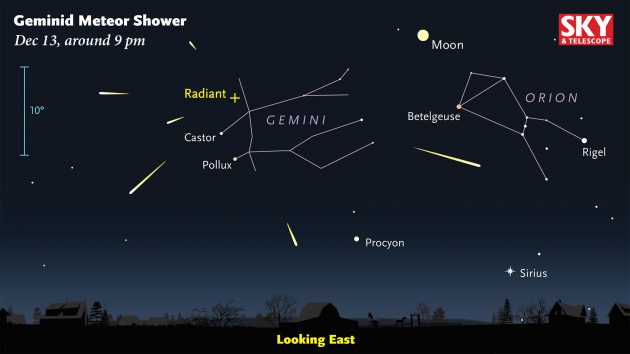A Sky & Telescope press release
Contact:
Alan M. MacRobert, Senior Editor
855-638-5388 x22151, [email protected]
| Note to Editors/Producers: You may use the illustration below. Open it in a new window for the high-res version. |

Sky & Telescope diagram.
The annual Geminid meteor shower should reach its peak late tonight (December 13th), but this year most of the meteors will be washed out of view by bright skyglow from the full Moon. What’s more, this will be an extra-bright full Moon that's closer to Earth than average.
Only the brightest of these "shooting stars" will shine through the moonlight. "Don’t expect to see more than a dozen or two Geminid meteors per hour," predicts Alan MacRobert, a senior editor at Sky & Telescope magazine.
But even a handful of meteors can be memorable, and it takes just one to make a wish.
The shower will be most active from about 9 or 10 p.m. Tuesday evening the 13th until dawn on Wednesday the 14th. Earlier in the evening, rates will be lower.
“The Geminids are usually one of the two best meteor showers of the year,” says MacRobert. “Sometimes they’re more impressive than the better-known Perseids of August. But moonlight is the bane of meteor observers. It’s nature’s own light pollution.” And there’s no moonlight like full moonlight.
To give it a try, find a spot with an open view of the sky and no glaring lights nearby. Bundle up warmly in many layers. “Go out late in the evening, lie back in a reclining lawn chair with your back to the Moon, and gaze into the stars in front of you,” advises MacRobert. “Be patient.”
A Geminid can flash into view anywhere in the sky. But if you trace its direction of flight backward far enough, you’ll find that this imaginary line crosses a spot in the constellation Gemini near the stars Castor and Pollux. Gemini is in the east during late evening and passes high overhead in the hours after midnight (for skywatchers at north temperate latitudes). The special spot is called the shower’s radiant. It’s the perspective point from which all the Geminids, which travel in parallel through space, would appear to come if you could see them approaching from far away.
The Source of the Geminid Meteors
The meteors in this shower are created by tiny bits of rocky debris (mostly the size of sand grains to peas) shed from a small asteroid named 3200 Phaethon, which was only discovered in 1983. Before then no one knew the source of the Geminid shower, which had been recognized as an annual phenomenon in the early 1860s.
Phaethon is small, only about 3 miles across, and it loops around the Sun every 1.4 years in an orbit that approaches the Sun closer than any other known asteroid. Researchers think Phaethon is a “rock comet” that sheds dusty debris each time it nears the Sun, when its surface fries to roughly 1,300°F (700°C) and rocky minerals on its surface crack, pop, sizzle, and fly off into space.
Over the centuries, these bits of Phaethon have spread all along the asteroid’s orbit to form a sparse, moving “river of rubble” that Earth passes through in mid-December each year. The particles are traveling 22 miles per second (79,000 mph) with respect to Earth at the place in space where we encounter them. So when one of them dives into Earth’s upper atmosphere, about 50 to 80 miles up, air friction vaporizes it in a quick, white-hot streak.
For skywatching information and astronomy news, visit SkyandTelescope.com or pick up Sky & Telescope, the essential guide to astronomy since 1941, with subscribers in more than 100 nations. Sky & Telescope and SkyandTelescope.com are divisions of F+W, a content and e-commerce company. F+W also publishes SkyWatch (an annual guide to the night sky) as well as books, star atlases, posters, prints, globes, apps, and other fine astronomy products.
 0
0
Comments
You must be logged in to post a comment.